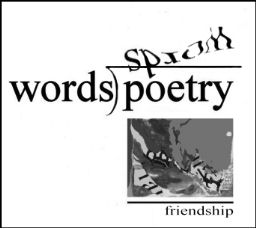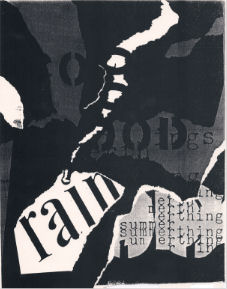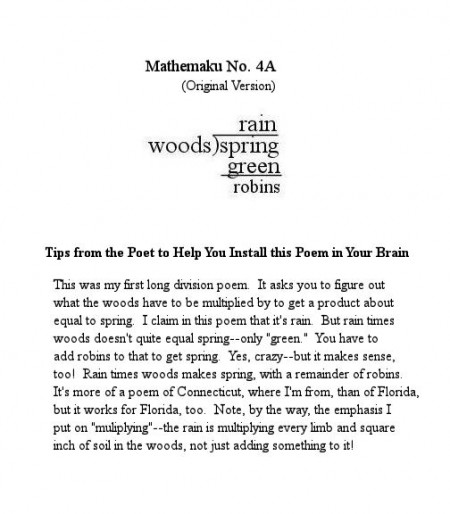Archive for the ‘Lessons in Poetry’ Category
Entry 756 — Next Commentary
Friday, June 1st, 2012
Here’s the introduction to my series of long division poems:
One day I thought of using “poetry” as a dividend. This would allow me to make almost any graphic as a near-synonym for it it—such as my “smmerthings.” My first thought was to divide “words” into it, since words are necessary for poetry. Since diction that is “slant” in Emily Dickinson’s sense, seems to me a major ingredient of good poetry (along with metaphorical slantness), although good poetry is possible without either, I quickly chose a distorted image of the word, “words,” as my quotient.
I’d composed the original version of “smmerthings” before I could use color. Now that color was easy for me to use, I wanted it. Adding it, I got carried away, and made a fairly extreme variation on my original poem.
By then, I’m fairly sure, I saw that I could make a series of similar long divisions. In each one, words told slant would multiply a different divisor to get a different variation of “summerthings,” and—therefore—a different remainder. It would be like dividing 90 by 9.001, 9.002, 9.003, etc.
Sometime after that, I added a prologue showing the evolution of the series beginning with my original version of “summerthings.”
This was the first of my divisions of poetry (shown in black and white because that’s how it will appear on the page containing my commentary on it, which follows under it) :

While at the Atlantic Center of Arts in New Smyrna Beach, Florida, for two weeks in 2001 thanks to Richard Kostelanetz, who chose me and several others to join him there for an all-expenses-paid workshop for artists under his leadership, I learned to use Photo Shop from Kathy Ernst, to whom I’ll be forever grateful, for it led to the full-color poems I now make—albeit not using Photo Shop but Paint Shop, another program that works the same way but is cheaper. One of the first of matheaku I made using Paint Shop when I got home from New Smyrna Beach was the above. I liked it well enough to make ten or twelve variations on it, each dividing something else into “poetry” and getting the distorted rendition of “words” as the answer.
Most of these, including this one, were pretty simple. The quotient represents Emily Dickinson’s idea of telling the truth “slant” in poetry. In this frame of the sequence that resulted, slant-words times regular words (or straight-forward language) yields a graphic (with words, or parts of words, in it) intended to suggest one example of what poetry is . . . almost. Almost, because to become a specimen of poetry, the graphic requires the addition of “friendship.” You see, in spite of how odd my poems are, and how befuddling they can seem, I do think they should be friendly, and therefore understandable. I also feel that any poem is more than anything else an act of friendship, a sharing of inner feelings made as arrestingly enjoyable as possible with others.
It is important to note that the graphic derives from my visual poem, “summerthings.” As my sequence continues, and each divisor changes, my graphic changes. It remains throughout based on “summerthings, although sometimes the connection is very hard to see. In any case, my hope is that it is always visually appealing.
.
Entry 755 — “summerthings” and Commentary
Thursday, May 31st, 2012
I’ve been toying with the idea of sending out samples of my work with commentary like the one below to galleries, museums and writers for visual art magazines. Apologies if I’ve already posted this.
“summerthings, a collage,” is the first visually non-representational visual poem I made. It may have been my first “large work”—i.e., the first of my visual poems to fill a whole page. I think I made it is the middle nineties. I remember showing it at a YRI meeting (a gathering of local poets) held in an unfortunately short-lived gallery-in-a-home a painter and his wife had on the Peace River near the bridge from Port Charlotte into Punta Gorda.
It later became important for me as the source piece for a number of variations in color I did of it, each of them acting as the “sub-dividend product” of a long series of long divisions into “poetry” I started ten years or so ago, and am continuing. As a work by itself, it is mostly what I hope seems an arresting design to a viewer. It is intended to put a viewer into a summer thunderstorm—like those I remember from my upbringing in Connecticut, but still often experience now that I live in Port Charlotte. The torn pieces of paper (construction paper, for the most part, in the original, are intended to suggest the idea of a thunderstorm’s tearing up a day as though it were paper.
The peculiar a I meant as an image of growth. In the bottom right-hand corner of the piece is a full-scale poem consisting of the word, “summerthings,” and word-game permutations of it. The other letters are present mainly for what they contribute to the graphics of the piece, but also to run wherever a viewer want to take them—“OOD” to “good” or “mood,” for instance.
.
Entry 734 — Hilton Kramer on Susan Sontag
Thursday, May 10th, 2012
Hilton Kramer, who recently died, was not a leading hero of mine but I agreed with him a lot more than I didn’t, and consider him one of the very few worthwile cultural critics of his generation, which I place just slightly before mine. The current issue of the New Criterion, which he co-founded, pays tribute to him, in part with a few excerpts from his writing, including the following:
On ‘‘A Susan Sontag Reader)
What gave Sontag’s early essays their aura of daring and controversy was the remarkable air of confidence she brought to the task of defending and codifying the values implicit in this movement to strip the arts of what she herself described as “moral sentiments?” Bidding a not-so-fond farewell to art that was conceived, as she put it, as “a species of moral journalism:’ she hailed the advent of a “new sensibility:’ whose most distinctive feature was said to be that “it does not demand that pleasure in art necessarily be associated with edification?’ Fundamental to the new sensibility-as she wrote in her manifesto-like essay “One Culture and the New Sensibility” in 1960s-was “a new attitude toward pleasure” And it was as the Pasionaria of this new, pleasure-seeking revolution in sensibility that Sontag emerged as a critical spokesman of the Sixties.
– From “Susan Sontag: The Pasionaria of Style” (1982), reproduced in The Twilight of the Intellectuals: Culture and Politics in the Era of the Cold War
I reproduce it because one of the reasons Kramer was not a leading hero of mine was due his insistence that art should be morally edifying. Of late, however, I’ve been wondering how much I genuinely believe that. For instance, isn’t my newest long division poem, a moral statement? It plainly tells those encountering that the arts and humanities are a damned good thing. Perhaps even more emphatically, it asserts that the achievements of human kind are of the greatest value.
Note: I’ve changed the remainder to “small clouds, dawdling west”–I felt a need to tone down the bliss of the poem.
Back to my poem’s morally assertive message, and it is that, my defense, after reflection, is that while the message is there, it is merely an excuse for the metaphors responsible for its aesthetic punch, if it has any: the multiplication of dead music that results in something fairer than morning–something, the poem now claims, rendered equal to humankind’s achievements by virtue of simple clouds doing what clouds quotidianly do. Properly attended to, in my opinion, the poem isn’t anything to argue or agree with, but to sensually enjoy. As are the poems of Stevens which so often, on the surface, are statements about aesthetics, but at the deepest far more than that.
.
Entry 708 — Long Division Poetry I, Lesson 1
Saturday, April 7th, 2012
.
My pwoermd for the day–remember that I’m doing a sequence of months; this one is where “June” would be expected. Pitiful, but maybe if I made the S look like a J, it’d work better? Nah.
.


